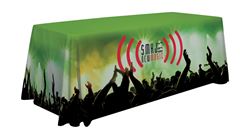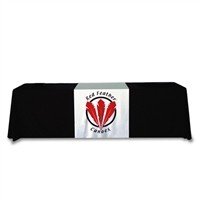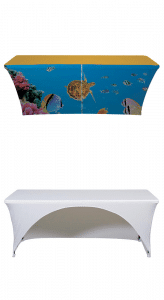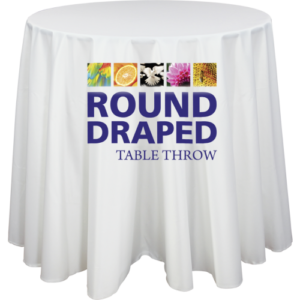Trade Show Table Covers & Runners
When you’re planning your trade show display, you want to make sure every aspect fits the theme and look of the space. That includes your trade show table covers – advertising space is at a premium in trade show booths, especially the smaller shows, so take advantage of all of your available advertising space.
This means, don’t settle with a dull black or white, boring table cloth! Instead, use a trade show table cover to synchronize with the rest of your displays, display your company color and logos, and highlight the products that you want to promote.
The trade show table covers offered by American Image Displays use 100% twill polyester, and pass NFPA 701 Small Scale & California Section 13115. Starting in 2020, we also offer trade show table covers and runners printed on 100% Recycled Fabric! See One Planet Fabric for more information.
When it comes to dressing a table for a meal or event, there are two primary linen options: table covers and table runners. While both serve the purpose of enhancing the appearance of the dining area, in tradeshows, they differ mostly in size. A table cover or table throw or tablecloth, is a large piece of fabric that drapes over the entire table surface, offering protection and a uniform look. On the other hand, a table runner is a narrow, long strip of fabric that typically runs down the center of the table or across it width-wise, providing a decorative accent.
Table Throw Sizes and Fit Options
| | |
Table Covers can fit the table in three different ways:
- They can be a loose fit, draping on the table,
- or "Fitted," meaning the fabric is trimmed and sewn at the corners
- Table throws can also be a stretch fit to the specific table size, with either a zippered flat panel or an arched panel in the back.
Table Covers come in 3 standard rectangular sizes (4ft, 6ft & 8ft widths). They are also available to fit round tables.
Table Runners are smaller, rectangular dye sub fabric prints (like the white runner on the black tablecloth to the right), designed to cover a narrow strip of a rectangular table. Table runner prices are generally about half the cost of a full table cover.
Most trade show tables are rectangular in shape, but there are also round table height and counter height tables, and we provide round table throws too. The available sizes for all standard tables are listed below too.
Custom sizes and shapes are also available, call for information.
Note - Most table throws and runners come with a laser heat-sealed edge.


Optional Soft Carry Bag
Table Throw Information:
Trade show table covers or table throws can be easily overlooked and are surprisingly underrated as an important and effective aspect of your trade show displays. Almost all exhibitors focus on the “heavy lifting”, creating an exhibit or trade show booth design, selecting the best trade show displays, and preparing large format graphics for the signs and banners. Those tasks are indeed the most important, but don’t forget the small details that can also impact your sales efforts.
Most companies have invested in professionally designed logos and branding, and that branding should be carried across all of your trade show display materials, including not only the banners and signs, but also the business cards, brochures, and other advertising. The branding should be consistent and uniform, and your table throws are just one more place to display that branding.
Picture this; your main display stand and trade show graphics are inviting and attracted some clients. Your representatives have welcomed these potential clients into your trade show booth, and you now have them in the sales area. They are ready to pick up pamphlets, or to give their contact information, or even to sign an order form, and their hand makes contact with a drab unprinted table cloth.
Up until this point, everything has been attractive and appealed to their sense of sight. That drab, plain black table cloth that the show gave you can look boring, if not cheap, compared to the rest of your booth, and is a lost opportunity to upgrade the look of your display space at a very low cost.
Printed trade show table covers are one of the most inexpensive tools available to use for marketing your products – they cost about the same as a single banner stand. They are appropriate in the smallest and largest of booth spaces. They can be used by themselves at small chamber of commerce and recruiting events, and can also be used at major trade shows. They always help to make the simplest display look attractive and professional, and can make a powerful combination when used with table top displays.
They can be used by themselves at small chamber of commerce and recruiting events and can also be used at major trade shows. They always help to make the simplest display look attractive and professional and can make a powerful combination when used with tabletop displays.
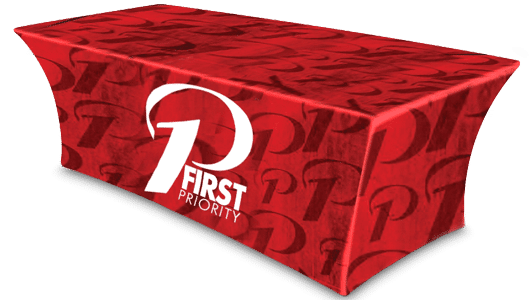
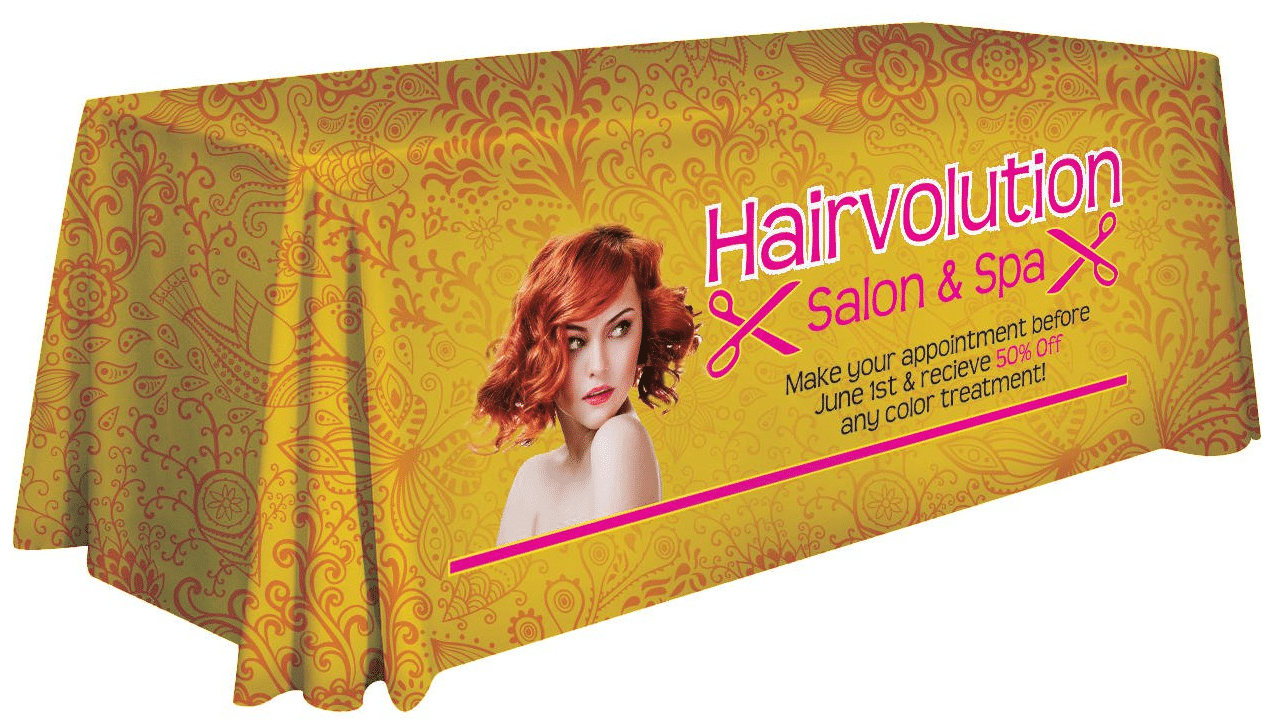
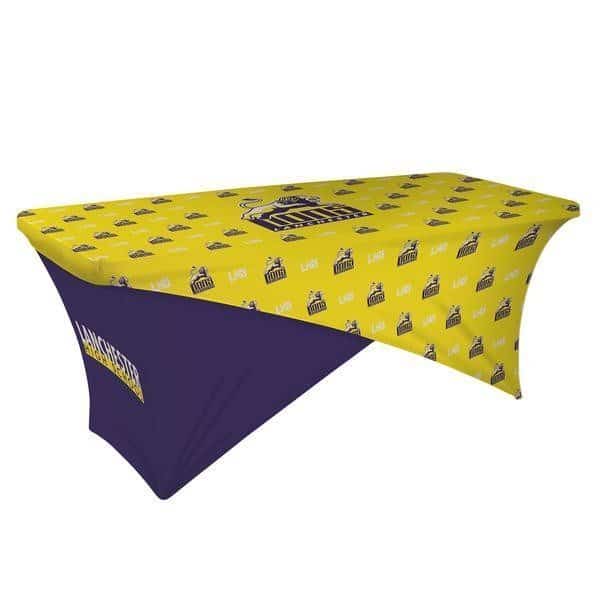
1) What size Trade Show Table Covers do you need?
There are a couple of basic choices for table throws; the first is whether you want to print your logo on an entire table cloth, or just on what is called a “table runner”.
Table runners are narrow strips of cloth, typically 30″ or 48″ wide, draped over a solid color table cloth (see black runner on yellow below). Printing narrow trade show table runners is less expensive than full size printed table cloths, so table runners can be a good option for tight budgets.
Table runners also help provide contrast your trade show table cover and your table runners. The contrast provided by using table runners can help your printed logo “pop”. Table runners cost a bit less than printing the entire table cloth. If you want a table runner, then all that is left is to choose the size of the runner, the background color, and the print method.
If you want a table cover, not a runner, then you need to select the size of the table cloth, so it fits the table. Standard trade show table sizes are 6ft wide and 8ft wide, approx 2ft deep, and 28″ high. If you’re unsure, keep in mind that an 8ft wide table cover will work on a 6ft table, simply by tucking the extra material under the table – but a 6ft wide table cloth will be too short to properly fit on an 8ft table.
There is also the choice of whether you want a back panel on the table cover, or an open back – some people prefer to hide what might be stored under the table, others prefer slightly easier access to that storage.
The black table cover in the picture above illustrates a 3 panel, or “economy” table cover – one without a back panel. The back panel only adds about $10 to the cost of your trade show table cover, so this choice is mostly about the desired style and look, not price.
2) What Is the Difference Between a Table Cover and a Table Runner?
In a word, "Size". A table cover or table throw or table cloth is sized to cover the entire table. A table runner is a narrow strip of cloth, typically laid across a table cover to provide some contrast in colors, and usually to highlight your business logo.
3) Which is the right print method for your Trade Show Table Covers?
There are three primary methods for putting your company logo on a table cloth - but the truth is, two of them are not used very much anymore.
Dye sub printing is offered on most table throws and is usually the best option. You can print the entire table cloth with your logo design and/or photo images. No size limits, nor restrictions. And you can specify the exact pantone(s) needed.
Dye sublimation (or more commonly, “dye sub”) printing has grown into being the standard print process for trade show usage in the last decade. It provides a full digital print, with no limitations on the number of colors, and it also allows pantone color matching if needed.
Dye sub printing costs have dropped significantly in the last few years. Other methods like vinyl heat transfers and screen prints used to offer lower costs, but that isn't really the case for most exhibitors.
Unless you're going to be ordering large quantities of the identical print, dye sub printing is a better solution. And if multiple colors are involved, or color transients and transitions, it is the only way to print on fabric.
We still offer vinyl heat transfer logos (applied the same way they are on sports jerseys) and screen printing. If you need these services, please just ask, and one of our experts will discuss your project with you.
Selection Process for Printed Expo Table Covers
Planning your printed trade show table covers is simple and doesn’t take much time. There are a couple of basic choices for table throws; the first is whether you want to print your logo on an entire table cloth, or just on what is called a “table runner”.
Table runners are a printed, narrow piece of cloth that is placed on top of a plain, unprinted table cloth – they can be used to provide a contrast of colors, to help your printed logo “pop”, and table runners cost a bit less than printing the entire table cloth. The photo above shows a plain black table cloth with a white printed runner placed on top.
You have two other choices involving the size of the table cloth; most tables used at trade shows and events are either 6ft or 8ft wide; besides the two standard sizes, there are some smaller 4ft demo table sizes, as well as round tables that can also be covered.
As part of the process of selecting printed table covers, you’ll need to specify which size table your printed table cover needs to fit.
You can also choose between having the table cloth cover all four sides of the table, or to leave the back side of the table open, as shown in the black table cover above. The normal recommendation is that you should not sit down or stand behind tables or counters while making sales presentations, but this doesn’t apply for special uses like registration tables, and if you will be sitting at the table, leaving the back panel off can make that a little easier.
The next choice involves the fit of your trade show table cover; these table cloths come in styles that drape loosely (for example, the red table cloth above), but they can also be styled to be a close fit, or even a stretch fit on your table. The example picture above shows a fitted table cover (no, that’s not a wrapped gift!); alongside are examples of printed, stretch table covers.
Once you’ve decided what size table cover you need, whether it needs a back panel, and how you want the actual printed table cover to fit to the table, the only selection left is the print method and coverage.
The print methods commonly used are screen printing, dye sublimation printing, and vinyl heat transfer. Vinyl heat transfer isn’t actually printing, but involves using a computer to precision cut your vinyl logo. This vinyl in the applied with heat to transfer it to the table cloth.
Most printed trade show table covers are made with a 100% polyester twill, selected to be wrinkle free if handled properly (take a minute to fold it up and keep it in a plastic bag, don’t crumple it up and stuff it somewhere for weeks between uses!). All of our table covers are treated and certified to meet trade show flammability and smoke requirements. Most can be machine washed (gentle cycle, gentle detergent), and tumble dried on low heat or laid out to air dry (don’t dry clean or press any trade show printed fabric graphics!).
What are the Different Types of Fabric Used for Promotional Table Covers?
Polyester poplin is probably the most commonly used fabric when it comes to promotional table covers because it is durable, relatively inexpensive, and is easily washable. It is not prone to wrinkling, staining, or flames, which makes it the ideal fabric to take to and from trade shows.
Polyester twill is another commonly used fabric and is woven and known for its diagonal weave. It is a popular fabric to choose for decorating because it is also easy to care for and machine washable. It also has a much heavier composition than other fabrics, which makes it a durable option for trade shows.
What is the Best Way to Store Trade Show Table Covers and Runners?
Some covers come in a tube. You can simply open the tube, unroll the cover onto the table and then position the top seam at the back of the table with the graphic you have printed facing the front so your audience can see.
To remove the cover, lay it flat with your graphics down. You can then fold the table cover in thirds. Make sure to fold lengthwise to keep the graphics on the inside of the fold.
When storing your table covers and runners, keep them in a cool and dry place in a soft carrying case or a polybag. When you use a soft-sided carrying case for your table cover, you can roll it instead of folding it.
Design Tips for Stunning Trade Show Table Covers and Runners
When it is time to design your new promotional table cover, you want to keep your branding in mind. The logo needs to pop to increase your booth traffic. So, choose a background color that lets the logo you use pop out more. You also want to make sure to only use high-resolution files so you can achieve the best imprint possible.
All letters you use on your tablecloths need to be big enough so they can be read from at least ten feet away from the table. The letters in the name on the tablecloth should be around two to three inches in height if you are printing on a 6-foot table cover.
Finally, make sure to keep the design for your custom table cover simple and not overly complicated or cluttered. Most people only glance at the table cover for a few brief seconds before they move on and forget what they saw. Simple and clean graphics that pop are the best for creating a more memorable table cover for your next trade show appearance.
As you can see, planning for printed table covers require a little bit of thinking, but it’s not rocket science – the selection process is pretty simple. The most expensive printed full-size table throw costs about $400; average costs for printed table throws is $200 – about the same price as a retractable banner stand, and just as universal and effective!

